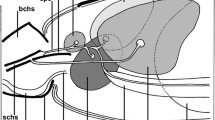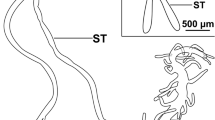Abstract
Salivary glands of 25 species of Opisthobranchia and Pulmonata gastropod mollusks were studied with the use of histochemical methods and cytophotometry of DNA in cellular nuclei. In the secretory epithelium, cells of three main types are identified: granular cells (with granular glycoprotein inclusions), mucocytes-I (containing sulphatized acid mucopolysaccharides), and mucocytes-II (containing neutral and acid nonsulphatized polysaccharides and protein), as well as epithelial ciliated cells and cells of ducts. It is shown that the salivary gland secretory cells of all studied mollusk species are polyploidized, but to different degree. In most species, the maximal degree of polyploidy estimated by the DNA content amounts to 64–128c. Giant polyploidy—up to 4096c—is revealed in salivary gland cells of Tritonia diomedea. The functional properties due to the peculiarities of nutrition of different molluscan species and phylogenetic tendencies of development of somatic polyploidy in the class of Gastropoda are discussed. The high degree of obligatory polyploidization revealed in salivary gland cells of the opisthobranchian and pulmonate mollusks is considered as a peculiar cytological arogenesis as compared with allogenic, facultative, and slight manifestations of polyploidy in prosobranchian gastropod mollusks. The probable causes of such differences are due to the euthyneural type of organization of the central nervous system and to the giant neuronal polyploidy in opisthobranchian and pulmonate mollusks. The causes, mechanisms, and significance of such correlations are so far unclear.
Similar content being viewed by others
References
Anatskaya, O.V. and Vinogradov, A.E., Paraoxical Relationship between Protein Content and Nucleolar Activity in Mammalian Cardiomyocytes, Genome, 2004, vol. 47, pp. 565–578.
Anatskaya, O.V., Vinogradov, A.E., and Kudryavtsev, B.N., Hepatocyte Polyploidy and Metabolism/Life-History Traits: Hypotheses Testing, J. Theor. Biol., 1994, vol. 168, pp. 191–199.
Anisimov, A.P., A Simple Method of Preparing Permanent Squash Preparations Using Cellophane, Tsitologiia, 1992, vol. 34, nos. 11/12, pp. 110–112.
Anisimov, A.P., Cell Proliferation and Somatic Polyploidy in Tissues of Gastropods: A Review. V. The Nervous System, Tsitologiia, 1999a, vol. 41, no. 1, pp. 14–22.
Anisimov, A.P., Cell Proliferation and Somatic Polyploidy in Tissues of Gastropods: A Review. VII. Somatic Polyploidy as a Morphogenetic Factor, Tsitologiia, 1999b, vol. 41, no. 1, pp. 32–39.
Anisimov, A.P., Endopolyploidy as a Morphogenetic Factor of Development, Cell Biol. Int., 2005, vol. 29, pp. 993–1004.
Anisimov, A.P., Tokmakova, N.P., and Poveshchenko, O.S., Somatic Polyploidy in Different Tissues of the Snail Succinea putris, Tsitologiia, 1995, vol. 37, no. 4, pp. 311–330.
Barow, M. and Meister, A., Endopolyploidy in Seed Plants Is Differently Correlated to Systematics, Organ, Life Strategy and Genome Size, Plant Cell Environ., 2003, vol. 26, pp. 571–584.
Beltz, B.A. and Gelperin, B.A., An Ultrastructural Analysis of the Salivary System of the Terrestrial Mollusc, Limax maximus, Tiss. Cell, 1979, vol. 11, pp. 31–50.
Boer, H.H., Groot, C., Dc, Jong-Brink, M., and Cornelise, C.J., Polyploidy in the Freshwater Snail Lymnaea stagnalis (Gastropoda, Pulmonata). A Cytophotometric Analysis of the DNA in Neurons and Some Other Cell Types, Neth. J. Zool., 1977, vol. 27, pp. 245–252.
Boer, H.H., Wendelaar, Bonga, S.E., and van Rooyen, N., Light and Electron Microscopical Investigations on the Salivary Glands of Lymnaea stagnalis L., Z. Zellforsch. Microsc. Anat., 1967, vol. 76, pp. 228–247.
Bogatov, V.V. and Zatravkin, M.N., Gastropoda of Fresh and Brackish Waters of the Soviet Far East, in Mollyuski. Rezul’taty i perspektivy ikh issledovanii (Mollusks. Results and Prospects of Their Study), Leningrad: Nauka, 1987, vol. 8 pp. 196–200.
Brodskii, V.Ya. and Uryvaeva, I.V., Kletochnaya poliploidiya. Proliferatsiya i differentsirovka (Cell Polyploidy. Proliferation and Differentiation), Moscow: Nauka, 1981.
Brodsky, V.Ya., Cell Polyploidy in the Mammalian Heart, in The Development and Regenerative Potential of Cardiac Muscle, New York: Harwood Acad. Publ., 1991, pp. 255–293.
Bullock, T.H. and Horridge, G.A., Structure and Function in the Nervous System of Invertebrates, San Francisco: Freeman, 1965, Vol. 2.
Edgar, B.A. and Orr-Weaver, T.L., Endoreplication Cell Cycles: More for Less, Cell, 2001, vol. 105, pp. 297–306.
Fischer, M.A., Velde, G., and Roubos, E.W., Morphology, Anatomy and Histology of Doto uva Marcus, 1955 (Opisthobranchia: Nudibranchia) from the Chilean Coast, Contribut. Zool., 2006, vol. 75, pp. 145–159.
Ghose, K.C., The Alimentary System of Achatina fulica, Trans. Amer. Microsc. Soc., 1963, vol. 82, pp. 149–167.
Golikov, A.N., and Starobogatov, Ya.I., Problems of Phylogeny and System of the Prosobranch Gastropods, Tr. Zool. Inst. AN SSSR, Leningrad: Nauka, 1988, vol. 187, pp. 4–77.
Haszprunar, G., On the Origin and Evolution of Major Gastropod Groups, with Special Reference to the Streptoneura, J. Mol. Stud., 1988, vol. 54, pp. 367–441.
Kirsanova, I.A., Somatic Polyploidy in the Central Nervous System of Pulmonary Gastropods, Extended Abstract of Candidate’s (Biol.) Dissertation, Vladivostok, 2003.
Kudryavtsev, B.N., Anatskaya, O.V., Nilova, V.K., and Komarov, S.A., The Relationships between Mitochondrial and Myofibrillar Apparatus of Cardiomyocytes with Their Level of Ploidy and Hypertrophy in Some Species of Mammals, which Differ in Body Weight, Tsitologiia, 1997, vol. 39, no. 10, pp. 946–964.
Kudryavtsev, B.N., Cell Mechanisms of Normal and Reparative Growth of Mammalian Liver, Extended Abstract of Doctoral (Biol.) Dissertation, St. Petersburg, 1991.
Kupper, T. and Pfitzer, P., DNA in Cardiac Myocytes of Normal and Miniature Pigs, in The Development and Regenerative Potential of Cardiac Muscle, New York: Harwood Acad. Publ., 1991, pp. 197–225.
Leal-Zanchet, A.M., Histology of the Salivary Glands of the Limacoidea and Milacidae (Gastropoda, Pulmonata), Rev. Bras. Zool., 2003, vol. 20, pp. 401–407.
Likharev, I.M., and Victor, A.J., Slugs of the Fauna of the USSR and Adjacent Countries (Gastropoda Terrestria nuda), in Fauna SSSR. Mollyuski (The Fauna of the USSR: Mollusks), Leningrad: Nauka, 1980, Vol. III, no. 5.
Lillie, R., Patogistologicheskaya tekhnika i prakticheskaya gistokhimiya (Histopathologic Technic and Practical Histochemistry), Moscow: Mir, 1969.
Lobo-da-Cunha, A., Ferreira, I., Coelho, R., and Calado, G., Light and Electron Microscopy Study of the Salivary Glands of the Carnivorous Opisthobranch Philinopsis depicta (Mollusca, Gastropoda), Tiss. Cell, 2009, vol. 41, pp. 367–375.
Lobo-da-Cunha, A., Ultrastructural and Histochemical Study of the Salivary Glands of Aplysia depilans (Mollusca, Opisthobranchia), Acta Zool., 2000, vol. 82, pp. 201–212.
Martynov, A.V., Nudibranchs (Mollusca: Nudibranchia) of the Northwestern Part of the Sea of Japan (with Remarks on the Order Nudibranchia), Extended Abstract of Candidate’s (Biol.) Dissertation, St. Petersburg, 1999.
Minichev, Yu.S. and Starobogatov, Ya.I., Subclasses of Gastropods and Their Phylogenetic Relationships, Zool. Zh., 1979, vol. 58, no. 3, pp. 293–305.
Moura, K.R.S., Terra, W.R., and Ribeiro, A.F., The Functional Organization of the Salivary Gland of Biomphalaria straminea (Gastropoda: Planorbidae): Secretory Mechanisms and Enzymatic Determinations, J. Mollusc. Stud., 2004, vol. 70, pp. 21–29.
Nagl, W., Endopolyploidy and Polyteny in Differentiation and Evolution, Amsterdam: North Holland, 1978.
Pearse, S., Gistokhimiya teoreticheskaya i prikladnaya (Histochemistry: Theoretical and Applied), Moscow: Izd. Inostr. Liter., 1962.
Pirger, Zc., Elekes, K., and Kiss, T., Functional Morphology of the Salivary Gland of the Snail, Helix pomatia: A Histochemical and Immunocytochemical Study, Acta Biol. Hung., 2004, vol. 55, pp. 221–232.
Quattrini, D., Osservazioni su un Passaggio di Ribonucleoproteine dal Citoplasma al Nucleo e su un Gruppo di Neuroni Secerneti nel Sistema Nervose Centrale die Molluschi Gasteropodi, Caryologia, 1960, vol. 13, pp. 444–468.
Sakharov, D.A., Functional Organization of Giant Neurons of Mollusks, Usp. Sovrem. Biol., 1965, vol. 60, no. 3, pp. 365–383.
Schreiber, M. and Schreiber, G., Researches on Quantitative Cytology, the Somatic Ploidy in Gland Tissues of Gastropods, Revista Biologia, 1964, vol. 57, pp. 285–300.
Sheffel, P. and Shaiba, B., Rasteniya i zhivotnye. Rukovodstvo dlya naturalista (Plants and Animals: Naturalist’s Guide), Moscow: Mir, 1991.
Shileiko, A.A., Nazemnye mollyuski nadsemeystva Helicoidea. Fauna SSSR. Mollyuski (Terrestrial Mollusks of the Superfamily Helicoidea. Fauna of the USSR. Mollusks), Vol. 3, no. 6, Leningrad: Nauka, 1978.
Swift, H., Quantitative Aspects of Nuclear Nucleoproteins, Int. Rev. Cytol., 1953, vol. 2, pp. 1–76.
Tabakova, E.V., Kirsanova, I.A., and Anisimov, A.P., Morphological Variability and Ploidy of the Nuclei of Neurons of the Central Nervous System of Bivalve Mollusks in Relation to Somatic Polyploidy, Biologiya Morya (Russ. J. Mar. Biol.), 2005, vol. 31, no. 5, pp. 352–357.
Tsikhon-Lukanina, E.A., Trofologiya vodnykh mollyuskov (Trophic Ecology of Aquatic Mollusks), Moscow: Nauka, 1987.
Veprintsev, B.N., Krasts, I.V., and Sakharov, D.A., Nerve Cells of the Nudibranch Mollusk Tritonia diomedea Bergh, Biofizika, 1964, vol. 9, no. 3, pp. 327–336.
Vinogradov, A.E., Anatskaya, O.V., Kudryavtsev, B.N., Relationship of Hepatocyte Ploidy Levels with Body Size and Growth Rate in Mammals, Genome, 2001, vol. 44, pp. 350–360.
Walker, G., Light and Electron Microscope Investigations on the Salivary Glands of the Slug, Agriolimax reticulates (Müller), Protoplasma, 1970, vol. 71, pp. 111–126.
Zhadin, V.I., Mollyuski presnykh i solonovatykh vod SSSR (Mollusks of Fresh and Brackish Waters of the USSR), Moscow: Nauka, 1952.
Zyumchenko, N.E. and Anisimov, A.P., Evolutionary Regularities of Somatic Polyploidy Manifestation in Salivary Glands of Gastropod Molluscs. I. Subclasses Cyclobranchia and Scutibranchia, Tsitologiia, 2000, vol. 42, no. 7, pp. 710–718.
Zyumchenko, N.E. and Anisimov, A.P., Evolutionary Regularities of Somatic Polyploidy Manifestation in Salivary Glands of the Gastropod Molluscs. II. Subclass Pectinibranchia: Order Anisobranchia, Tsitologiia, 2001a, vol. 43, no. 5, pp. 446–452.
Zyumchenko, N.E. and Anisimov, A.P., Evolutionary Regularities of Somatic Polyploidy Manifestation in Salivary Glands of the Gastropod Molluscs. III. Subclass Pectinibranchia: Orders Discopoda, Echinospirida, Aspidophora, and Entomostoma (Mesogastropoda), Tsitologiia, 2001b, vol. 43, no. 6, pp. 19–26.
Zyumchenko, N.E. and Anisimov, A.P., Evolutionary Regularities of the Somatic Polyploidy Manifestation in Salivary Glands of Gastropod Molluscs. IV. A Subclass of Pectinibranchia: Orders Hamiglossa and Toxoglossa (Neogastropoda), Tsitologiia, 2002, vol. 44, no. 5, pp. 431–440.
Author information
Authors and Affiliations
Corresponding author
Additional information
Original Russian Text © A.P. Anisimov, N.E. Zyumchenko, 2012, published in Tsitologiya, 2012, Vol. 54, No. 2, pp. 165–175.
Rights and permissions
About this article
Cite this article
Anisimov, A.P., Zyumchenko, N.E. Evolutionary regularities of development of somatic polyploidy in salivary glands of gastropod mollusks: V. Subclasses Opisthobranchia and Pulmonata. Cell Tiss. Biol. 6, 268–279 (2012). https://doi.org/10.1134/S1990519X12030029
Received:
Published:
Issue Date:
DOI: https://doi.org/10.1134/S1990519X12030029




